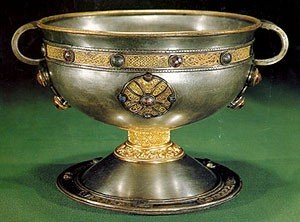Secrets of the powers of that be
Visitors to the national Museum are often astonished by the relics of early Christian Ireland that are on show there, from the Derrynaflan hoard and the Broighter boat, to the Ardagh Chalice and the Cross of Cong.
But what many do not realise are the hazards of survival that make such finds a rarity.
One of the new files (2016/1/1296) reveals what has to be done in some cases to ensure the survival of cultural relics in Ireland.
The file concerns the discovery in June 1986 of a Book Shrine on the bed of Lough Sheelin. The allocation to the museum was raised by an exceptional £90,000 to cover the costs involved in the find.
The museum was alerted to the existence of the shrine in November 1986. They met with the legal representatives of the finders and were presented with a formidable and restrictive agreement to sign. They were prepared to give a receipt for the actual shrine which needed urgent conservation, but would not sign the agreement.
Trouble
The trouble was that the State Property Act of 1954 did not cover the so call larger “state lakes”, and right to them had become contentious in recent times. The matter, according to a government memo never published, is very complicated.
The Shrine, according to a confidential report prepared for the Taoiseach’s Department by Assistant keeper Éamonn Kelly, had already been shown to a foreign dealer who had made an offer for it. But the finder suspected he would have to offer it to the Museum, so they wanted to approached the museum themselves first.
They had an elevated idea of its value and were seeking £100,000. The legal advice from the Attorney general office was that a ex-gratia payment should be made which would not preclude the State’s right of ownership, as it had been found in a “state lake”.
The matter was urgent. The museum was well aware from previous experience that items can simply disappear, being melted down for the gold value. “It will be clear that it is in the national interest to bring this transaction to a satisfactory conclusion at the earlier possible opportunity.”
The find was also stated to be “of immense importance having major implications for the dating and provenancing of other metal work and manuscripts of the period.” They thought the sum sought “was entirely reasonable”. On the open market it might have been worth 2 million pounds. The find place was indicated to the museum, but the finders undertook not to interfere further with it.
As a matter of urgency the matter of an allocation to cover the costs was pushed through the Cabinet.
In the papers released the shrine is assigned to Lough Sheelin. In actual fact it was found on the bed of nearby Lough Kinale, Co. Longford, beside a small crannog.
It now recognised as the largest and oldest of Irish book shrines. It was in parts and there is a suggestion that it was looted in Viking times and an attempt made to strip it of its decorative elements.
After its acquisition by the National Museum of Ireland it was decided that the find-place would be re-examined to see if any components had been overlooked by the finders and to search for clues which might elucidate the circumstances surrounding the deposition of the shrine. No additional components of the shrine were found. The crannog dated from the first half of the 12th Century – the home of some local chief on the eve of the Norman invasion.
Although in a dismantled state most of its components survived and the object can be almost completely reconstructed.
The Shrine is 30.5cm long, 28cm wide and is 11cm in depth. It consists of a wooden box to which metal plates are nailed, with the whole being strengthened by tubular binding strips along the corners and sides. It is the earliest and largest example of Irish book shrines and enough detail remains to enable it to be dates to the eight century.
It is hoped to have it restored to its original splendour in the near future.


 Peter Costello
Peter Costello